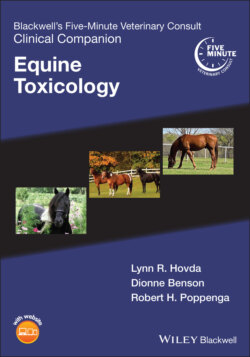Читать книгу Blackwell's Five-Minute Veterinary Consult Clinical Companion - Группа авторов - Страница 19
DIAGNOSTICS
ОглавлениеDiscriminating between differential diagnoses may require ancillary diagnostics:Histopathology:Samples for histopathology should be collected in 10% formalin.Bouin’s solution can be used for delicate tissues (i.e. ophthalmic, gastrointestinal and reproductive tissues). Bouin’s solution is not a good fixative for preserving ultrastructure for electron microscopy.Tissues should not exceed 0.5 cm thickness to permit proper fixation. Bloody tissues (i.e. liver and spleen) should be thinner.A set of samples should minimally include liver, kidney, lungs, GI tract and any tissues with lesions.Brain and/or spinal cord are needed if there are neurologic signs.Do not freeze formalin‐preserved tissues.Microbiology:Sterile culture swabs or large sections of any tissues with lesions should be sent fresh (refrigerated, not frozen) for microbial work‐up.Serology/immunology:Whole bloodSerumPlasmaMolecular diagnostics:1 cm square section of fresh (unfixed) tissue with the lesion in a sterile container refrigerated or frozen depending on transport time.Analytical toxicology:Use laboratories accredited by the American Association of Veterinary Laboratory Diagnosticians (AAVLD). These can be accessed at https://www.aavld.org/accredited‐labsFreeze appropriate unfixed tissue specimens for toxicology testing.Use separate containers for each specimen (i.e., do not combine samples into one container). Label each sample.If in doubt, contact the toxicology laboratory for advice on sample types and amounts, including collection and preservation of environmental samples.
Conduct a detailed field investigation to identify, remove and/or restrict access to source(s) of toxicants.
Samples for toxicology fall into three general categories (see Table 2.2):Environmental (e.g. pasture samples, weeds, feed and feed supplements, water, soil, pesticide containers).Antemortem (e.g. whole blood, serum, urine, hair).Postmortem (e.g. stomach contents, liver, kidney, perirenal fat, brain).TABLE 2.2. Samples for toxicology: guide to collection and analysis.Sample Type Amount Condition Potential Analyses EnvironmentalHay, grain, concentrate feeds, mineral supplements500 g to 1 kg compositeIn paper or plastic bags, glass jars; avoid spoilage during shippingPesticides (insecticides, rodenticides, herbicides), heavy metals, salts, feed additives, antibiotics, ionophores, mycotoxins, nitrates, sulfate, cyanide, plant toxins, cantharidin, botulinum toxin, vitaminsPlantsEntire plantPress and dry or refrigerate or freezeIdentification, alkaloids, tannins, grayanotoxins (rhododendron), cardiac glycosides (oleander, foxglove, adonis)MushroomWholeKeep cool and dry in paper bagIdentification; chemical test for amanitinsWater1 LPreserving jarPesticides, salts, heavy metals, microcystins, anatoxin‐a, sulfate, nitrate, pH. For blue green algae identification mix water:10% neutral buffered formalin (50:50) to preserve the cellsSource/bait; soil500 g to 1 kgFreeze in bag or glass jarInclude package label; variety of toxicantsAntemortemWhole blood*5–10 mLEDTA anticoagulantCholinesterase activity, lead, selenium, arsenic, mercury, cyanide, some organic chemicals, anticoagulant rodenticidesSerum*5–10 mLSpin and remove clot; special tube for zincCopper, zinc (no rubber contact if testing for zinc), iron, magnesium, calcium, sodium, potassium, drugs, alkaloids, oleandrin, vitamins, anticoagulant rodenticidesUrine*50 mLSend in plastic, screw‐cap vialIllicit drugs, some metals (arsenic, mercury), alkaloids, cantharidin (blister beetle), fluoride, paraquat, oleandrinFeces (collect at different time points)100 g plusFreezePlant identification (if not too macerated), seed identification, cardiac glycosides (oleander, foxglove, adonis), grayanotoxins (rhododendron), alkaloids (yews, poison hemlock), tannins, pesticides, illicit drugs, cyanide, ammonia, cantharidin (blister beetle), 4‐aminopyridine (Avitrol®), petroleum hydrocarbons, antifreeze, heavy metals, ionophores, algal toxinsBiopsy specimensE.g., liver, fatFreezeMetals, pyrrolizidine alkaloids (histopathology), potentially other toxicants depending on size of the sampleHair10 gTie mane/tail hair so origin and base are evidentPesticides, some heavy metalsPostmortemIngesta (collect stomach, small intestine and large intestine contents; keep separate)500 gFreeze, collect separate samples from stomach, small and large intestinePlant identification (if not too macerated), seed identification, cardiac glycosides (oleander, foxglove, adonis), grayanotoxins (rhododendron), alkaloids (yews or poison hemlock), tannins, pesticides, drugs, cyanide, ammonia, cantharidin (blister beetle), Avitrol®, petroleum hydrocarbons, antifreeze, heavy metals, ionophores, algal toxinsLiver100 gFreeze†Heavy metals, pesticides, some plant toxins, some pharmaceutical or illicit drugs, vitaminsKidney (cortex)100 gFreeze†Heavy metals, calcium, some plant toxins, ethylene glycolBrainHalf of brainFreeze†; sagittal section (leave midline in formalin for pathologist; unfrozen for AchE)AchE activity, sodium, organochlorine insecticides; yellow star thistle (histopathology), bromethalinFat100 gFreeze†; smaller OK for biopsy samplesOrganochlorine insecticides, PCBsOcular fluidOne eyeFreeze†Potassium, ammonia, magnesium, nitrateInjection site100 gFreeze†Injectable drugs; malicious injectable toxicantsMiscellaneous100 gSpecial tests, usually freeze†Special tests, e.g., spleen (barbiturates), lung (paraquat)* If possible, whole blood, serum and urine should also be collected during a postmortem examination.† Frozen is best for toxicology samples, but refrigerated is best for bacterial cultures.
